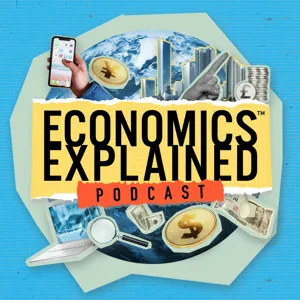Podcast Summary
Economic outlook and labor market complicate Fed's plans: The economic outlook is shifting, but the extent and timing of necessary Fed action remains uncertain due to the labor market situation
The economic outlook has shifted dramatically in recent weeks, with optimism surrounding a soft landing and an end to interest rate hikes becoming the conventional wisdom. However, the labor market situation may complicate this scenario, as there are signs of softening but the extent and timing of any necessary Fed action remains uncertain. Economist Jan Hadzias of Goldman Sachs shares his insights on the current macro cycle and what to expect in 2024. While some may view the current period as the "hard part" following the easy gains of inflation reduction, Hadzias argues that the opposite is true. The full understanding of this macro cycle will likely continue to unfold for years to come. Principal Asset Management, with its 360 degree perspective and expertise across public and private equity and debt, can help investors navigate these complex economic waters. For more information, visit principalam.com. Investing involves risk, including possible loss of principal. Principal Asset Management SM is a trade name of Principal Global Investors LLC. American Express Business Gold Card offers 4 times points on top spending categories, providing powerful backing for businesses. Terms apply. Learn more at American Express dotcom/businessgoldcard.
Goldman Sachs economist predicts more disinflation: Goldman Sachs economist Jan Hatzius expects more disinflation, as indicated by declining inflation rates and labor market rebalancing, without causing a recession.
According to Goldman Sachs economist Jan Hatzius, the hardest part of fighting inflation is over, and there is more disinflation on the way. Hatzius points to the success of central banks, including the US Federal Reserve, in bringing down inflation without causing a recession as evidence. He specifically mentions the decline in inflation rates across G10 and EM economies, with core inflation dropping from 6% to around 3%. Housing and rent inflation, which has a significant impact on core inflation indices, is expected to continue declining. Additionally, labor market rebalancing, as indicated by decreasing job openings and quit rates, is contributing to disinflation. Hatzius acknowledges that there are long lags in the impact of monetary policy on inflation, but as a forecaster, he focuses on the maximum impact on the growth rate, which he believes has already occurred without causing a recession.
Understanding the unique economic cycle: The current economic cycle is different from past ones due to COVID-19, and the Fed's role in controlling inflation may slow down growth. Economic forecasting is uncertain, and interpretations of indicators like the SOM rule can vary.
The current economic cycle, shaped significantly by the COVID-19 pandemic and its aftermath, is different from past cycles. The Fed's role in slowing down inflation is connected to the economy growing more slowly than it would have without tightened policy. However, the uncertainty of economic forecasting means that being wrong is always a possibility. The ongoing debate around economic indicators like the SOM rule and its relevance to the current labor market shows that there are different ways to interpret the data. Historically, significant increases in the unemployment rate have coincided with recessions in the US, but this might not be the case in the current cycle, given its unique characteristics. While it's essential to acknowledge historical facts, it's also important to consider the limitations of the sample size and the applicability of such rules outside the US.
Labor market indicators beyond unemployment rate: While unemployment rate increase is a concern, other labor market indicators like payroll growth, household survey employment numbers, and initial jobless claims remain strong. A significant deterioration in these indicators, along with a jump in initial claims and declines in payroll growth, could signal a recession.
While an increase in the unemployment rate is a concern, it shouldn't be the sole indicator of a recession. Other labor market indicators, such as payroll growth, household survey employment numbers, and initial jobless claims, have remained strong. A significant deterioration in these indicators, along with a jump in initial claims and declines in payroll growth, could signal the need for rate cuts. However, the labor market is currently forecasted to continue improving, and the Fed's ability to respond to weaker numbers has reduced the risk of recession. The decline in job openings, which was previously a sign of an overheated labor market, is now seen as a good thing as it puts the labor market on a more sustainable footing.
Global inflation trends shaped by pandemic recovery: The pandemic's impact on global economies has led to similar inflation trends, emphasizing the importance of considering global factors in economic analysis, even as policy responses differ and surveys become less representative.
The global economy's inflation experience during the COVID-19 pandemic has been a common factor, dominating other influences. Despite differences in policy responses among countries, the recovery from the pandemic has been the primary driver of inflation trends. For instance, European inflation data, which previously appeared higher than that of the US and other countries, is now seeing significant improvement. This convergence highlights the importance of acknowledging global factors when analyzing economic data, even if response rates have decreased and surveys may be less representative. Economists have put more weight on hard data to mitigate potential sentiment effects and ensure accurate assessments of the economic situation. The proof of concept of significant disinflation and mild labor market weakening across ten countries underscores the importance of this approach.
US Federal Deficit: A Growing Concern: The US federal deficit, currently around 6-7% of GDP, is much larger than after the 2008 crisis and is a structural deficit that could crowd out private investment and lead to higher interest payments, impacting economic growth and the federal budget.
While the US fiscal response played a significant role in supporting economic growth during the COVID-19 crisis, the large and growing federal deficit is a cause for concern. The deficit, which is currently around 6-7% of GDP, is much larger than during the aftermath of the 2008 crisis and is a structural deficit that will need to be addressed over time. The concern is that if the deficit continues to grow, it could crowd out private sector investment and potentially lead to higher interest payments, which could further strain the budget and the economy. While it's not clear when or how this issue will be addressed, it's important to note that the deficit is expected to remain large in the near term, especially during the 2024 presidential election year. This could potentially lead to higher interest payments and a larger fiscal burden, which could impact economic growth and the federal budget.
US economy's resilience in 2023: Real income growth and investment: Real income growth, driven by wage increases and falling inflation, continues to fuel the US economy in 2023. Investment in sectors like clean energy is also contributing to growth.
The resilience of the US economy in 2023 can be attributed to the growth in real disposable income, despite a decline in savings and the impact of inflation. Real income growth, driven by wage increases and falling headline inflation, is expected to continue at a healthy pace. The economy is also seeing a high level of investment in certain sectors, particularly clean energy, but the macro impact from fiscal changes is not expected to be significant. Productivity readings have been positive, but it's unclear whether this is due to exogenous tech breakthroughs or cyclical factors. Overall, the economy is expected to continue growing, but there are concerns about what will support consumer spending once excess savings run out.
Productivity growth in the lawn and farm business: Productivity growth in the lawn and farm business has been around 1.5% annually since Q4 2019, with potential for a significant lift from AI later in the decade. Staying informed and adaptable is crucial for understanding the evolving macroeconomic picture.
It's important to consider various factors when analyzing productivity growth, including the employment mix and the impact of new technologies like AI. However, the productivity data are noisy and it's uncertain if the recent gains are sustainable or if we're seeing the productivity boost from AI yet. Productivity growth has been around 1.5% annually in the lawn and farm business since Q4 2019, which is slightly better than before the pandemic but not significantly. Looking ahead, there's potential for a sizable productivity lift from AI later in the decade. Incorporating new themes and topics into research and forecasting, such as AI and supply chain disruptions, requires being eclectic and drawing on a wide range of information. For instance, analyzing occupational classifications and tasks can help assess which jobs could be replaced by AI. Additionally, monitoring layoff filings can provide insights into labor market trends. Despite the challenges, staying informed and adaptable is crucial for understanding the evolving macroeconomic picture.
The ECI provides reassuring insights about the economy's growth: The ECI projects a 2% growth rate, stable unemployment, and decreasing inflation in the next year. The Fed is not expected to cut rates until late 2024, but a labor market indicator would signal a potential recession.
While the U.S. economic indicators like the Employment Cost Index (ECI) may not provide groundbreaking insights compared to more conventional datasets, it has been a helpful indicator that generally tells a slightly more reassuring story about the economy's growth and continues to do so. In the next 12 months, the growth rate is expected to remain around 2%, with the unemployment rate staying relatively unchanged. Inflation is projected to come down, but still above the official target. The Federal Reserve (Fed) is not expected to cut interest rates until the last quarter of 2024, but there are downside risks to this baseline scenario. If there is a significant slowdown in US growth or a recession, a labor market indicator would be the most important sign to look out for. Economists like Jan Hatzius of Goldman Sachs emphasize that due to the unusual nature of the current business cycle, it's essential to make qualitative judgments based on the data rather than relying solely on statistical significance. With a relatively small sample size of business cycles, it's important to consider the context and nuances of the data to gain a more accurate understanding of the economic situation.
Challenging economic assumptions in the current situation: Stay informed and adapt to the unique economic factors of the current situation, including mortgage rates, survey responses, and supply side issues.
The current economic situation, particularly the ongoing decline in inflation despite labor market weakness, challenges the assumptions made based on historical examples. The policy response, shift in consumption patterns, and other unusual factors make this economic cycle different from past recessions. It's crucial to approach economic analysis with humility and an open mind, considering the many unique aspects of the current situation. Some of these factors include the prevalence of locked-in 30-year mortgage rates, changes in survey responses, and supply side issues. The economic landscape continues to evolve, and it's essential to stay informed and adapt to new developments. To delve deeper into these topics, check out the Odd Lots podcast and follow Tracy Alloway, Joe Weisenthal, and their team for more insightful discussions. Additionally, don't miss out on Matt Levine and Katie Greifeld's new podcast, Money Stuff, for weekly finance and Wall Street news.




